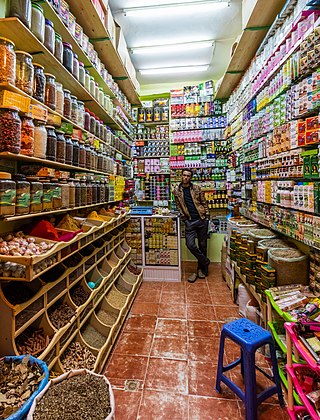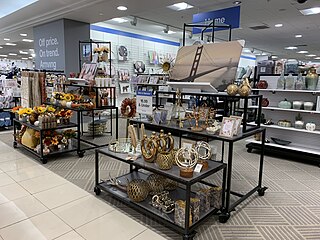E-commerce is the activity of electronically buying or selling products on online services or over the Internet. E-commerce draws on technologies such as mobile commerce, electronic funds transfer, supply chain management, Internet marketing, online transaction processing, electronic data interchange (EDI), inventory management systems, and automated data collection systems. E-commerce is the largest sector of the electronics industry and is in turn driven by the technological advances of the semiconductor industry.

The economy of Morocco is considered a relatively liberal economy, governed by the law of supply and demand. Since 1993, in line with many Western world changes, Morocco has followed a policy of privatisation. Morocco has become a major player in African economic affairs, and is the 5th largest African economy by GDP (PPP). The World Economic Forum placed Morocco as the most competitive economy in North Africa, in its African Competitiveness Report 2014–2015Archived 19 January 2022 at the Wayback Machine.

The economy of South Korea is a highly developed mixed economy. By nominal GDP, the economy was worth ₩2.24 quadrillion. It has the 4th largest economy in Asia and the 14th largest in the world as of 2024. South Korea is notable for its rapid economic development from an underdeveloped nation to a developed, high-income country in a few generations. This economic growth has been described as the Miracle on the Han River, which has allowed it to join the OECD and the G20. It is included in the group of Next Eleven countries as having the potential to play a dominant role in the global economy by the middle of the 21st century. Among OECD members, South Korea has a highly efficient and strong social security system; social expenditure stood at roughly 15.5% of GDP. South Korea spends around 4.93% of GDP on advance research and development across various sectors of the economy.

Retail is the sale of goods and services to consumers, in contrast to wholesaling, which is sale to business or institutional customers. A retailer purchases goods in large quantities from manufacturers, directly or through a wholesaler, and then sells in smaller quantities to consumers for a profit. Retailers are the final link in the supply chain from producers to consumers.

The video game industry is the tertiary and quaternary sectors of the entertainment industry that specialize in the development, marketing, distribution, monetization and consumer feedback of video games. The industry encompasses dozens of job disciplines and thousands of jobs worldwide.

Lost luggage is luggage conveyed by a public carrier such as an airline, seafaring cruise ship, shipping company, or railway which fails to arrive at the correct destination with the passenger. In the United States, an average of 1 in 150 people have their checked baggage misdirected or left behind each year.
Circana, formerly known as IRI Worldwide and The NPD Group, is an American market research and technology company. Its global headquarters is in Chicago, Illinois, USA. Circana operates in 20 countries and 24 industries. The current name, Circana, was adopted in 2023 after the company's merger with IRI. In October 2021, NPD entered intro an agreement to be acquired by private equity firm Hellman & Friedman.
eBags is an online retailer of handbags, luggage, backpacks, laptop bags, and travel accessories that was founded in Greenwood Village, Colorado near Denver.

An electronic shelf label (ESL) system is used by retailers for displaying, typically on the front edge of retail shelving, product pricing on shelves that can automatically be updated or changed under the control of a central server.

Longchamp is a French leather goods company, founded in Paris in 1948 by Jean Cassegrain. The company pioneered luxury leather-covered pipes before expanding into small leather goods. Longchamp debuted women's handbags in 1971, becoming one of France's leading leather goods makers. Today, the company designs and manufactures leather and canvas handbags, luggage, shoes, travel items, fashion accessories, and women's ready-to-wear. The house is privately owned and managed by the Cassegrain founding family and does business in 80 countries through around 1,500 retail outlets.

Retailing in India is one of the pillars of its economy and accounts for about 10 percent of its GDP. The Indian retail market is estimated to be worth $1.3 trillion as of 2022. India is one of the fastest growing retail markets in the world, with 1.4 billion people.
India has an Internet user base of about 690.0 million as of November 2023, about 40% of the population. Despite being the second-largest user base in world, only behind China, the penetration of e-commerce is low compared to markets like the United States, or France, but is growing, adding around 6 million new entrants every month. The industry consensus is that growth is at an inflection point.

Pakistan holds a significant position in the global rice market and is one of the leading rice-producing countries. The rice sector is crucial for the country's economy, providing livelihoods to a substantial portion of the population and contributing substantially to agricultural exports.

Between 2009 and 2014, gas consumption, production, and imports in China have grown dramatically, with two-digit growth. According to CNPC, the installed capacity of gas-fired power plants in the country is expected to reach around 138 million-154 million kilowatts in 2025, and further grow to 261 million-308 million kilowatts by 2030.

Clothing industry or garment industry summarizes the types of trade and industry along the production and value chain of clothing and garments, starting with the textile industry, embellishment using embroidery, via the fashion industry to apparel retailers up to trade with second-hand clothes and textile recycling. The producing sectors build upon a wealth of clothing technology some of which, like the loom, the cotton gin, and the sewing machine heralded industrialization not only of the previous textile manufacturing practices. Clothing industries are also known as allied industries, fashion industries, garment industries, or soft goods industries.

Off-price is a trading format based on discount pricing. Off-price retailers are independent of manufacturers and buy large volumes of branded goods directly from them. The off-price retail model relies on the purchase of over-produced, or excess, branded goods at a lower price, thus being able to sell to consumers at a discount compared to other stores which purchased an initial run. Among the largest retailers of this type are TJX Companies and Ross Stores. The model is more common in countries that import fashion-oriented or household goods, as the discount role in producer countries is usually filled by factory outlets or small-scale open-air marketplaces.
Youth travel is travel by youth. Unlike typical vacations, youth travel is motivated by several factors, including the desire to experience other cultures, build unique life experience, and benefit from formal and informal learning opportunities from other countries, including education or work abroad.

The COVID-19 pandemic caused far-reaching economic consequences including the COVID-19 recession, the second largest global recession in recent history, decreased business in the services sector during the COVID-19 lockdowns, the 2020 stock market crash, the impact of COVID-19 on financial markets, the 2021–2023 global supply chain crisis, the 2021–2023 inflation surge, shortages related to the COVID-19 pandemic including the 2020–present global chip shortage, panic buying, and price gouging. The pandemic led to governments providing an unprecedented amount of stimulus, and was also a factor in the 2021–2022 global energy crisis and 2022–2023 food crises.

An automotive part retailer is a retail business that sells automotive parts and related accessories to both consumers and professional repair shops, through physical stores and websites. Some automotive parts retailers also offer customer support and services related to automotive maintenance and repair.

A sporting goods retailer or sporting goods store is a retail business selling sporting and recreational goods, including sportswear, sporting equipment and related general merchandise.















